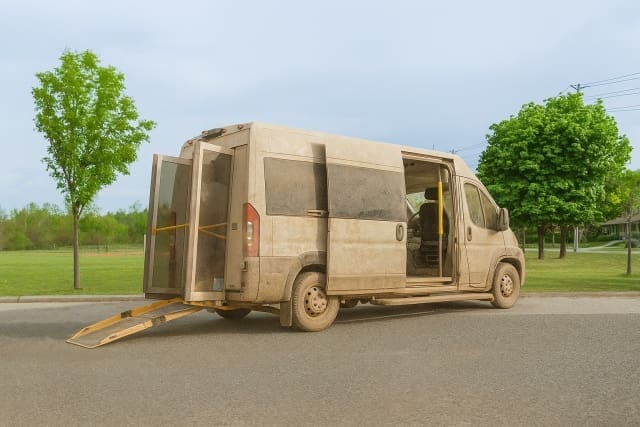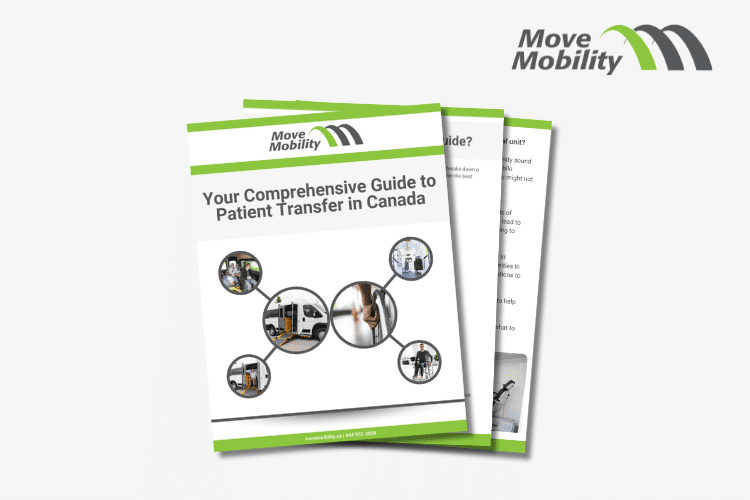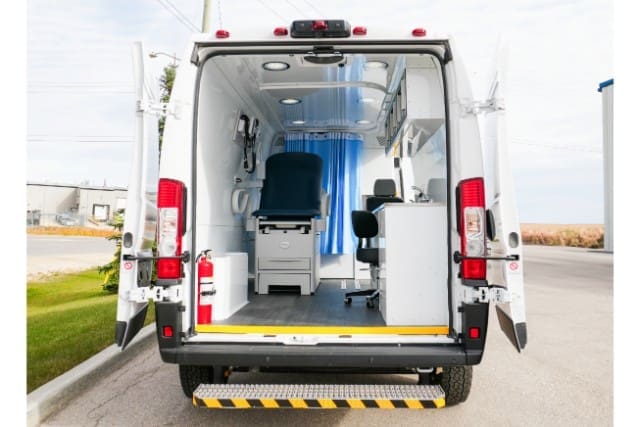Dust might seem like a small thing, but it can cause big problems, especially if you operate a wheelchair accessible van. If you drive on gravel roads or in dry areas like the windy plains of rural Saskatchewan, dust can find its way inside fast. Every time you open the doors, more gets in. It settles on seats, floors, and even into the air vents.
This matters a lot if your riders have asthma or other health issues. Breathing in dust can make symptoms worse. It can also cause wheelchair lifts to jam over time or make it harder to keep medical gear clean. That’s frustrating for you and uncomfortable for the people you serve.
You want to give your riders a clean, safe ride. But dust keeps getting in the way. We get it. We’ve seen it happen in vans used by health teams, non-profits, and transit agencies across Canada.
MoveMobility has been building wheelchair vans made for real conditions for over twenty years. We know what works and what doesn’t, and organizations all over Canada rely on us for their wheelchair accessible vehicle solutions.
In this article, you’ll learn:
- Where dust comes in
- What it does to people and equipment
- How to stop it before it becomes a problem
Let’s get started.
Where does all that dust come from?
Summer in Canada is great… until everything turns into a dust bowl. If you’re driving a wheelchair van on gravel roads, you know exactly what we mean. One dry stretch of weather and it feels like you’re towing a sandstorm behind you.
Dust doesn’t just stay outside either. It finds a way in. No matter how careful you are, that fine layer of grit still shows up on your floor, your seats, and sometimes even in your cup holder. How? It sneaks in through a few key spots in the van.
Here’s where dust usually gets in:
- Rear doors: The biggest troublemaker. The back of the van is where the ramp or lift is, and that’s often the most used part of the van. Gaps around the rear doors let dust sneak in while you drive, especially if you’re behind other vehicles kicking up gravel.
- Lift hatch or undercarriage: Some lifts don’t seal tightly, especially if you’re driving an older wheelchair van. The seals can leave small gaps underneath or around the edges when they’re not in use, which is enough for dust to slip through.
- Cracks in weather stripping: Over time, the rubber seals on doors can wear down or shift. Once they’re no longer tight, dust takes full advantage.
It doesn’t take long for that dust to pile up. But the real problem isn’t just the mess. In the next section, we’ll show you how it affects your riders, your equipment, and your peace of mind.
What can dust do to your wheelchair van and your clients?
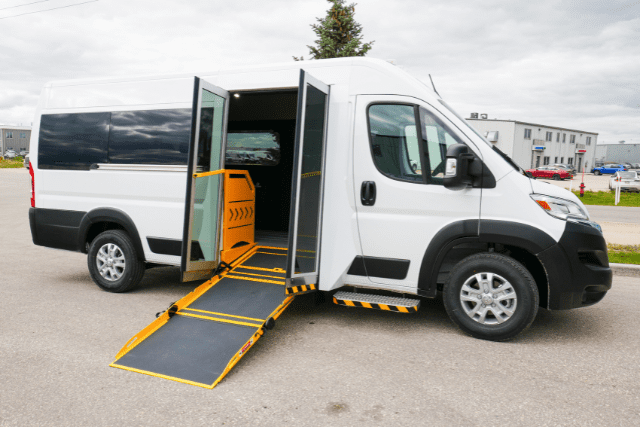
Dust might seem harmless, but once it gets into your wheelchair van, it can start to cause real problems. It affects people riding inside, the equipment you use every day, and even how your van performs.
How does dust affect people?
Riders often feel the effects of dust first, especially in the summer if windows are down or the van’s been sitting out on a dry, gravel lot.
- Breathing problems: Dust in the air can trigger asthma attacks, make it harder to breathe, or cause coughing fits. People with COPD or allergies are especially sensitive.
- Irritated eyes and skin: Dust can make eyes red and itchy. It can dry out skin or cause rashes, especially if it settles on seats or seat belts.
- Discomfort for vulnerable riders: Some passengers might already be dealing with serious health issues. Breathing in dust can make them feel worse quickly.
- Bad first impression: Whether it’s a client, patient, or support worker, riding in a dusty van doesn’t feel professional or clean.
A 2021 study from the Journal of Occupational and Environmental Hygiene shows that prolonged exposure to airborne dust in enclosed spaces increases respiratory stress and allergic reactions in people with sensitivities.
What does dust do to equipment?
Dust can ruin even the toughest tools and parts. Once it builds up, it clogs, jams, and wears everything down faster.
- Ramps and lifts: These systems need to run smoothly every time. But dust collects in the moving joints and gears, making them creak, slow down, or stop working altogether.
- Mobility devices: Dust can get into the wheels, electronics, and motors of wheelchairs or scooters. It makes parts grind and causes things to fail sooner.
- Tie-downs and buckles: These small but important parts can get gritty and hard to use. Dust wears out the fabric and weakens the straps over time.
- Floors and seats: Dust can cause your wheelchair van’s interior to get coated in grime. Cleaning takes longer, and the materials can break down quicker with constant friction from dust.
Impact on the van itself
Think of dust like sandpaper. It slowly wears everything down, even parts you can’t see.
- Air vents and fans: Dust can clog the HVAC system, causing airflow problems and bad smells. If the filter gets blocked, it can overwork the fan motor.
- Wiring and electronics: Fine dust can get into control panels or sensors. This leads to unexpected errors or total failures.
- Paint and finishes: Every time you wipe down dusty surfaces, it scratches them. Over time, the van’s interior and exterior start looking rough.
Interferes with sterilization
Keeping a clean space matters a lot if you serve clients with medical needs. But dust makes that hard.
- Makes it harder to clean: Dust hides in corners, under seats, and in crevices. It takes longer to fully clean the van between riders.
- Can carry germs: Dust can carry bacteria, viruses, and mold spores. Once it settles, it becomes a landing zone for germs.
- Looks unsanitary: Even if your team disinfects everything, a dusty interior still gives the impression that it’s not safe.
Dust can shorten your van’s lifespan
A wheelchair van is a big investment. Dust can quietly chip away at it.
- More repairs: When dust clogs vents, sensors, or moving parts, you’ll see more service calls and maintenance bills.
- Lower resale value: Dust can stain or damage the interior. Buyers notice wear and tear fast.
- Rust and corrosion: Dust holds moisture if it gets damp, which can speed up rust, especially in small cracks or seams.
Makes your HVAC work harder
The heating and cooling systems keep your riders safe and comfortable. Dust works against that.
- Filters clog faster: Dusty filters mean weaker airflow and uneven temperatures in the van.
- Higher energy use: Your system runs harder and longer just to keep up.
- Unpleasant smells: Dust mixed with moisture creates a musty smell that’s tough to get rid of.
Damages the interior air quality
This isn’t just about comfort. Air quality inside the van matters, especially during longer trips.
- Can trigger health symptoms: Even if your passengers don’t have pre-existing conditions, dust can still cause headaches, dry throats, and irritation.
- Makes the ride feel stale: Clean, fresh air feels better. Dusty air makes rides feel stuffy and long.
Fun fact: The EPA warns that indoor air pollution can sometimes be 2 to 5 times higher than outdoor levels, and dust is a major reason why.
Now that you’ve seen what dust can do, the next step is learning how to stop it before it gets in. Keep reading to learn more about that.
How do you stop the dust from getting in?
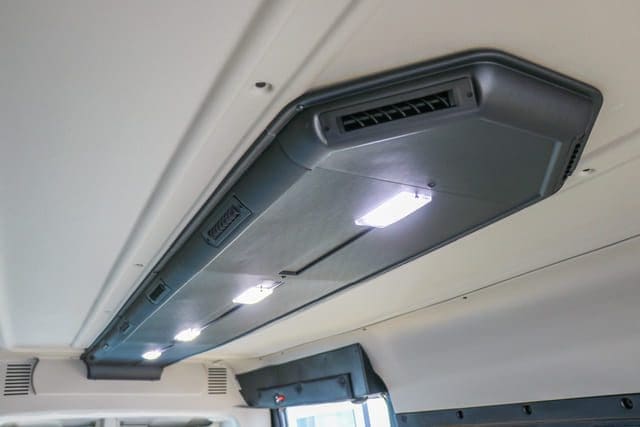
Now that we know what dust can do, let’s talk about how to stop it in its tracks. The good news? You don’t need fancy tools or high-tech filters. A few simple habits and smart add-ons can make a big difference.
1. Keep the rear fan blasting
When the rear fan is running at full speed, it creates positive pressure inside your van. That means air is being pushed out faster than it can sneak in.
- Why it works: With the fan blowing out, outside air (and dust with it) can’t sneak through cracks or gaps in the back doors. Instead, clean air moves out, not in.
- What happens if it’s off: You basically roll out the welcome mat for dust. It may find its way in and settle in on extremely dry, gravel roads or windy days.
- Make it a habit: Train your drivers to turn the rear fan on full blast as soon as they start the van, especially on rural or gravel roads. It’s one of the easiest and cheapest ways to fight dust.
Next, we’ll look at seals, doors, and cleaning routines that keep your van cleaner and your riders happier.
2. Check and seal the back doors
Even the smallest gap around your rear doors can act like a little vacuum for dust. It doesn’t take much; just a loose seal or worn-out weather stripping can cause dust to seep in.
- Where to look: Run your hand along the edge of the back doors. If you feel air coming in while the van’s running, that’s a sign your seals are letting dust sneak through.
- What to do: Replace worn rubber seals or add extra weather stripping. It’s a small fix that makes a big difference.
- Bonus tip: Shut the doors firmly. If they’re not closed all the way, you’re basically asking dust to move in.
Think of your van like a cooler. If the lid doesn’t seal tightly, food goes bad fast. The same goes for dust. If the doors aren’t sealed up right, it’ll get in and stay in.
Next, let’s talk about how your cleaning schedule can make or break your fight against dust.
3. Stick to a regular cleaning routine
Dust loves to settle in places you forget about, like under the seats, around the lift, and inside air vents. Once it’s in, it doesn’t leave quietly. A solid cleaning routine keeps it from building up and causing problems.
- Vacuum often: Especially around the lift, floor tracks, and corners. These are dust’s favorite hiding spots.
- Wipe down surfaces: Use a damp cloth to clean dashboards, seats, and control panels. Dry dirt just floats back up into the air.
- Clean the lift and ramp: Dust can clog up moving parts and sensors. A quick wipe can save you a big repair bill later.
Skipping cleanings might not seem like a big deal at first. But that dust builds up over time, grinds into surfaces, and wears things down faster.
Next, we’ll look at how your choice of driving routes might be stirring up more dust than you realize.
4. Avoid dirty roads when you can
Lastly, gravel roads might take you where you need to go, but they’re also dust factories. Every bump and tire spin kicks up a cloud that clings to your van like glue. And that dust sneaks inside, especially through the back.
- Stick to paved roads: If there’s a route that keeps you on asphalt longer, take it. It’s worth the trade, even if it’s a few minutes more.
- Slow down on gravel: Driving fast kicks up more dirt. A slower pace means less flying grit.
- Wait it out: If another vehicle just passed you on a dirt road, give it a moment before driving through their dirt cloud.
Sure, sometimes gravel roads are the only option. But if you can steer clear of them or reduce how often you’re on them, you’ll keep your van much cleaner and your passengers breathing easier.
Got any follow-up questions about wheelchair vans?
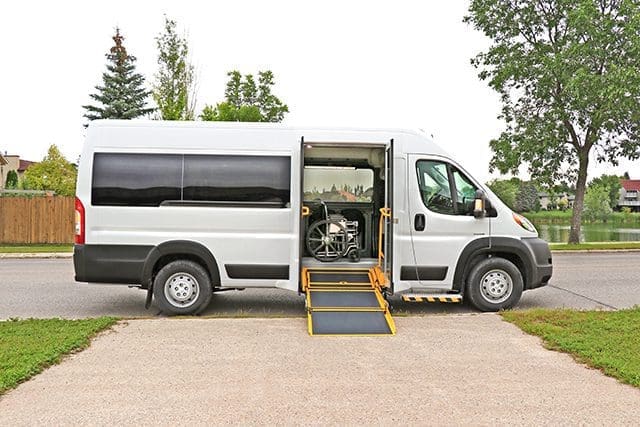
You likely landed here because your wheelchair van keeps filling up with dust. Or, maybe you’re on the verge of purchasing a new wheelchair van and wondering how to prevent this issue before it occurs.
Here’s what you picked up after reading:
- You learned where dirt gets in (mainly from the back of the van).
- You discovered how it harms both people and equipment.
- You explored easy ways to stop the dust before it causes damage.
At MoveMobility, we design every vehicle to handle tough Canadian conditions, from gravel roads to dusty job sites. Our team works closely with healthcare organizations, community organizations, and transportation services across the country to build solutions that truly work. Every decision we make is built on one goal: making sure people can travel safely, comfortably, and with dignity.
If you have questions, click the button below to talk to a real-life mobility expert who actually gets it.
Not quite ready to talk to someone yet? We have a couple of other resources to help you keep learning.
If you’ve made it this far and your wheelchair van is on its last legs, you may also be interested in our article or video below on the benefits of purchasing a new wheelchair van.
After that, another question that may also be on your mind is how to troubleshoot battery drainage problems with your wheelchair van. Check out our article on that to learn more.


